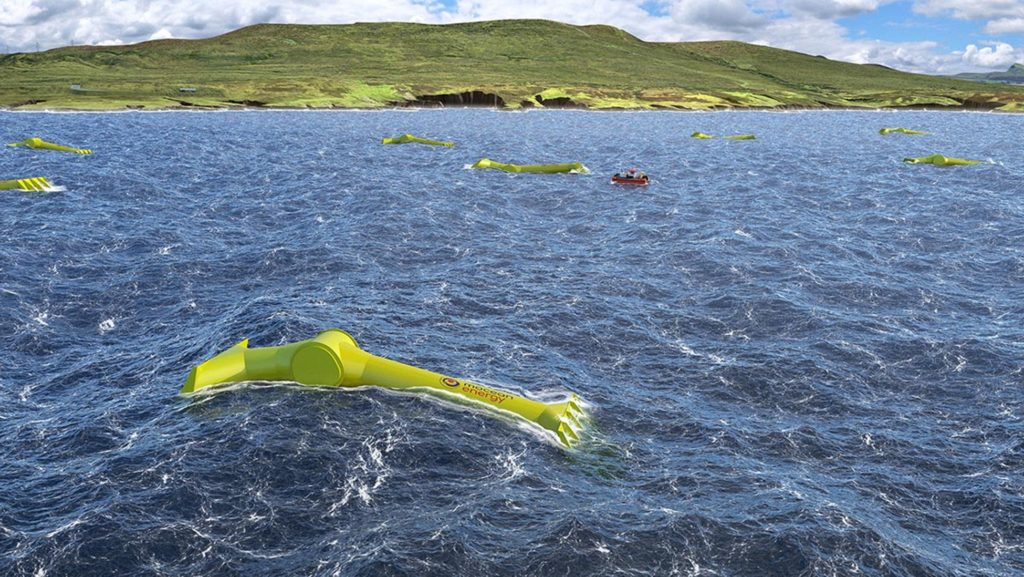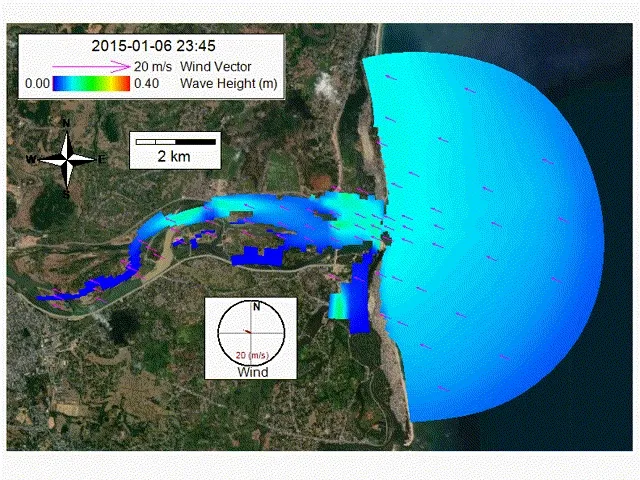
High wind speeds associated with hurricanes are capable of producing extreme waves, and high winds, currents, and tides can combine to create storm surge. Wind wave modeling in EFDC+ can compute hydrodynamic variables driven by storm winds, air pressure, tides, river flows, and wave-current interactions. Wind wave modeling predicts the evolution of the energy of wind waves and wave transformation in the sea state using numerical methods.
Wave hindcasts and forecasts can have important commercial utility. For example, wave modeling is a critical step for wave energy development and many studies have been carried out in different parts of the world to characterize wave resources at various temporal and spatial scales and resolutions. Figure 1 shows wave energy converters (WECs) as they transport and capture the energy created by ocean surface waves.

Wave parameters, such as wave height, wave direction, and wave period are used to model the wave field. In EDFC+ Explorer (EE), two options are available to simulate waves in an EFDC+ model; the Sverdrup Munk Bretschneider (SMB) model and the Simulating WAves Nearshore (SWAN) model.
SMB is an internally coupled model that allows interaction between waves and the resuspension of sediment inside EE. The wind time series is used to compute the instantaneous wave parameters with a fetch calculation for each cell in 16 directions. The effects of shoreline and EFDC+ internal masks are also included in the fetch calculations. The resulting wave parameters are used to calculate total bed shear stress, which is then linked to the current-generated shear stress using the Grant Madsen approach (Grant and Madsen, 1982).
SWAN model is developed at the Delft University of Technology, and it was introduced in EEMS in 2017 as an option to model wave field. SWAN provides additional execution options to simulate physical processes such as wave generation, wave dissipation, linear wave refraction, shoaling effects, nonlinear wave-wave interactions, and frictional dissipation, some of which are not available in SMB.
In EEMS 10.3, we updated and simplified EEMS graphical user interface (GUI) for simulating wind-induced waves (Figure 2). The user can now generate new SWAN input files or use existing SWAN format results. After setting up all SWAN configurations in EE, user can press “Run SWAN” to compute random, short-crested, wind-generated wave propagation. The SWAN executable file is installed as part of the installation package for EEMS. The user can also install the latest version of SWAN separately, if needed. The SWAN execution window is a typical command prompt. The modeled wave parameter can be visualized in EE in “2DH View”.
We created an example model for the Trakhuc Estuary in Vietnam (Figure 3). The model output can be viewed as an animation. The animation shows the change in wave height as a function of wind speed and direction. The arrows point toward the wind direction and the size of arrows signifies the magnitude. The color ramp shows the change in wave height in the model domain.
Want to give it a try? You can start by downloading this model from the EEMS downloads page and run it using the demo version of EEMS.

References
- DSI, 2020. EE Modeling System, Version 10.2.2 DSI, LLC, Edmonds, WA, USA, April 2020, available from Downloads
- Grant, W.D., and O.S. Madsen. 1982. Movable bed roughness in unsteady oscillatory flow. J. Geophys. Res., 87, 469-482.
- SWAN – Implementation manual. Delft University of Technology, Environmental Fluid Mechanics Section, available from http://www.swan.tudelft.nl (Version 41.31, May 2019)

